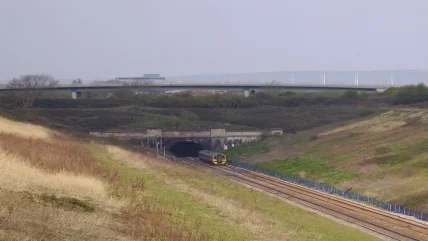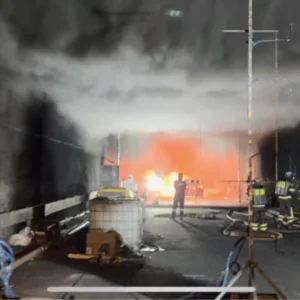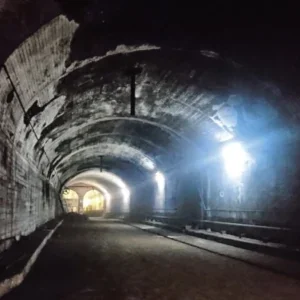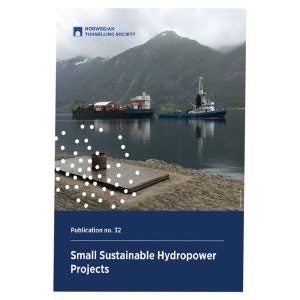
Tunnels and their associated works, including caverns, form a vital part of the infrastructure of a modern society. But tunnels do not come cheaply and have usually been considered the solution of last resort when significant physical and economic barriers had to be crossed. But the inexorable growth in urbanisation and current concerns about the environment are changing all that.
Now, it is often cheaper to tunnel beneath urban areas, where land costs and property values are typically high, which more than offset the additional costs of tunnelling.
In the mid-19th century, London was the largest city in the world and it is not surprising that, among its firsts, was the provision of a comprehensive system of sewers to serve six million people, discharging treated effluent into the Thames. The Metropolitan Line, built by cut and cover, opened in 1863 and was to be the precursor of many metro systems around the world. The City and South London Railway, opened in 1890, then introduced deep-level bored tunnels and electric traction to those facilities.
Somewhat earlier, construction of the railway system – the first mass mover of people – necessitated construction of some 150 tunnels of about 800m or more in length in the UK by the end of the century. The 7km-long Severn Tunnel, still in daily use, was opened in 1886 and was the longest sub-aqueous rail tunnel in the world at the time.
Among UK innovations in tunnelling during this era were the development of shields for soft-ground tunnels by the elder Brunel and Greathead; the patenting of compressed air for the exclusion of water from tunnels by Cochrane; the development of prefabricated linings for the City and South London Railway; the beginnings of immersed tube tunnels, with a full-scale trial in 1811; and the soft ground tunnelling machines of Thomson and Price which built the Central London Railway.
Tunnels are primarily used to transport water, people, power and goods, as well as for communications. Although the same methods of tunnel construction are common to all of them, it is useful to consider tunnels in terms of their end use, since the justification for their construction has to be the benefits they bring to society.
Water Tunnels
Apart from mining, man’s initial forays underground were to tap and convey spring water. Equally important is the removal of sullied water from the community and the disposal of run-off from rainfall; greater lengths of tunnel are required to perform these functions than for the supply of potable water. London’s requirement for the conveyance of clean water has tended to dominate the picture.
The capital is fortunate in that much of it is underlain by deposits of London Clay, a stiff, fissured formation which, in general terms, is about as ideally suited to tunnelling as any geological formation can be. Tunnellers have developed methods and systems of tunnelling to exploit this advantage.
The development of expanded precast concrete linings is perhaps the most important. Starting with two short experimental lengths of tunnel in 1950-52, the 27km Thames- Lee Tunnel of 2.6-2.7m ID was constructed in 1955-59 using the Don-seg lining. Wedge block lining, developed from the Don-seg lining, was first used experimentally in this tunnel. By 1975, some 60km of such water tunnels had been constructed in and around London, with much of the tunnel excavation performed by mechanical digger shields. More recently, some 38km of the 48.8km of new tunnels for the Thames Water Ring Main beneath London was constructed in similar fashion. Finished in 1994, two years ahead of programme, the out-turn cost of US$391.8m was within the budget of US$395m.
Mechanical digger shields and wedge block linings were used to build the 19.5km Ely-Ouse Tunnel through the Gault Clay in East Anglia and the 13.9km Empingham Reservoir Tunnel in the Lias Clay further north. A feature of this system of tunnelling is the outstanding rates of progress. With excavation and lining erection times of 3–5 minutes respectively, weekly progress of more than 200m was commonplace.
In the north-east of England, the Kielder Aqueduct, which contains 28km of tunnels driven through Carboniferous strata, was constructed in the late 1970s to transfer water from the Kielder Reservoir via the Tyne southwards to the Tees and the industrial area around Middlesbrough.
Sewage
Sewer tunnels probably constitute the greatest share of the tunnelling market this century, many of them aimed at bringing the 19th century systems up to modern standards and removing pollution from the inland waterways into which they discharged.
The Tyneside Sewerage Scheme led the way in the 1970s, to be followed by similar schemes in the Don Valley at Sheffield and by MEPAS in Liverpool. Significant lengths of sewer tunnel were also constructed in London and other cities including Bristol, Edinburgh, Leicester and Oxford during this period. With the river pollution problem under control, the emphasis is now on improving bathing waters and has resulted in considerable tunnelling activity along the coastline, notably at Blackpool, Brighton, Clacton and Penzance.
An important innovation in the 20th century was the bentonite tunnelling machine invented by John Bartlett in 1964 in response to his firm’s involvement with the Milan Metro. After full-scale trials at New Cross, London, in 1972, an improved machine of 2.9m OD was used to drive a 1km length of sewer tunnel in the loose sands at Warrington.
Hydro-Electric Schemes
These tunnelling schemes have been mainly confined to the Scottish Highlands, where a number of projects were carried out between 1950 and 1980. Among them were the pump storage schemes at Cruachan and Foyers, with installed generating capacities of 400MW and 300MW respectively. The most recent project was the 1800MW Pumped Storage Scheme at Dinorwig in North Wales, opened in 1984.
Both nuclear- and fossil-fuel power stations need a supply of cooling water and there are many examples where driven and immersed tube tunnels have been used. Examples of the latter are the immersed tube tunnels at Kilroot, Northern Ireland, commissioned in 1979, and at Sizewell B Nuclear Station (1987-93) on the Suffolk coast. A similar technique was used for the cooling water system at South Humber Bank Combined Cycle Gas Fired Station in the 1990s, where the precast units were lowered into a trench dredged in the bed of the Humber River.
Rail Tunnels
Most of the tunnels for the UK’s rail system were driven in the 19th century, with a few notable exceptions, such as the Potters Bar tunnels on the East Coast Main Line, completed in the 1960s, and tunnels for the Stansted Airport Link and the Heathrow Express.
The Channel Tunnel, with 102km and 51km of running and service tunnels respectively, has recently received the accolade ‘Civil Engineering Project of the Century’ against competitors like the Hoover Dam and Chek Lap Kok Airport (T&T International, May and July 1999).
The Lower Chalk was almost ideal for tunnelling, particularly on the UK side, where progress rates of 400m/week were recorded. Even on the French side, where the ground was more difficult, rates of up to 300m/week were achieved. Although the Channel Tunnel project is generally associated with financial difficulties and late opening due to problems with the rolling stock and operational systems, the tunnels were delivered on time. There are currently similar problems on London’s Jubilee Line Extension.
Considerable tunnelling has taken place for mass transit systems in urban areas. Glasgow’s underground railway opened in 1896, while in London the construction of the City & South London Railway was followed by a spate of tunnelling work, during which the middle sections of the present Bakerloo, Central, Northern and Piccadilly Lines of the London Underground system were driven in tunnels beneath the centre of the capital in the opening decade of the twentieth century.
The next 50 years saw little tunnelling apart from the Central Line extension until construction of the Victoria Line in 1969-71. The section of the Fleet Line – subsequently renamed and incorporated into the Jubilee Line – between Baker Street and Charing Cross stations followed in the 1970s. Finally, tunnelling for the Jubilee Line Extension to Stratford was completed in 1998. The 20th century has also seen construction of the Tyneside Metro, which involved considerable tunnelling under Newcastle and Gateshead, and construction of the Liverpool Loop and Link.
Road Tunnels
With its relatively flat topography, the need for road tunnels in the UK is not large but, like major bridges, tunnels are often crucial links in the highway network. London’s needs first emerged in the 19th century in the elder Brunel’s Thames Tunnel between Rotherhithe and Wapping, and the Blackwall Tunnel, completed in 1897. A further five tunnels have followed: Rotherhithe opened in 1908; the Dartford crossing, begun in 1936 and completed in 1960; the Blackwall duplication opened in 1964; and the Dartford duplication finished in 1977.
Liverpool followed this lead with the single-tube, four-lane Mersey Queensway Tunnel constructed in 1925-1934. The duplication of this system by the twin-tube, two-lane Mersey Kingsway tunnels (1966-74), driven through the Triassic sandstones by TBM, provides a total length of road tunnel beneath the River Mersey of 7.5km, which, in 1998 alone, carried some 25m vehicles. The Clyde Tunnel in Glasgow (1957-63) and the Tyne Tunnel (1961-67) below Newcastle were both constructed in more difficult ground, the problems faced being reminiscent of those encountered during the construction of road tunnels beneath the Thames.
There has been considerable tunnel construction on the motorway and trunk road system. The Crindau Tunnel (1962-67) on the M4 at Newport was the first tunnel on the motorway system, while the 1990s have seen construction of the Round Hill Tunnel (1990-93) on the A20 near Folkestone, and the Southwick Hill tunnels (1992-95) on the A27 Brighton Bypass, both using NATM. The 1980s and 1990s saw Penmaenbach and Pen-y-Clip tunnels driven by drill-and-blast on the A55 North Wales Coast Road. The cargo tunnel (1966-68) under the runways at Heathrow was shield-driven in soft ground and has an expanded precast concrete lining.
Cut and Cover
Noteworthy examples of this method of tunnel construction are: the 1.15km dual three-lane tunnel on the M1 at Hatfield, built during the 1980s; the Bell Common and Holmesdale Tunnels on the M25, opened in 1984; the main access to Heathrow Airport, built in the post war years; and the dual two-lane,1.8km-long Limehouse Link in London, opened in 1993 to provide road access from the west to the redeveloped Docklands. The immersed tube tunnels constructed at Conwy on the A55 in North Wales and under the Medway in Kent were opened in 1991 and 1996 respectively.
The Post Office put its first telecommunications cables in a pneumatic railway tunnel which had been abandoned in 1880 and then forgotten, only to be unearthed by a gas explosion in 1928. This process has continued and there is today an extensive network of tunnels carrying such cables beneath central London. In the 1970s, similar telecommunications tunnels were driven under Cardiff.
Electricity cable tunnels were constructed under the Thames (1967-69) and Severn-Wye (1969-72). More recently, over 40km of cable tunnels have been driven under London to house distribution cables. Such installations, while competitive in cost when compared to installing cables in trenches in city streets, also have the benefit of reducing traffic congestion during construction and providing a permanent hole in the ground through which replacement cables can be laid.
Defence Of The Realm
The impending World War II provided the stimulus for building telecommunications tunnels and the 200 offices below the Treasury Building in London, the latter protected by 5m of reinforced concrete.
Existing tunnels were also put into service and a 4.8km section of the Central Line was converted into an aircraft components factory. Eight deep air-raid shelters were driven adjacent to stations on the London Underground.
The views expressed in this article are solely those of the authors. If there are omissions, we apologise but we are conscious that our knowledge of events in the earlier years of this period depends on the literature. Readers who would like to delve more deeply into the history of tunnelling could start with the following:
- Sandstrom, G E. 1963. The history of tunnelling. Barrie & Rockliff, London.
- Rolt, LTC. 1970. Victorian engineering. Penguin Books, London.
- West, G. 1988. Innovation and the rise of the tunnelling industry. Cambridge University Press, Cambridge.
- Trench, R and Hillman, E. 1984. London under London. John Murray, London.
- Craig, R N and Muir Wood, A M. A review of tunnel lining practice in the United Kingdom. Transport & Road Research Laboratory, Crowthorne.
At the time of writing in September 1999, Eric Snowdon was Chairman of the British Tunnelling Society; Myles O’Reilly was Chairman of the Tunnels & Tunnelling International Editorial Advisory Board. The images shown here were not part of the original presentation.






